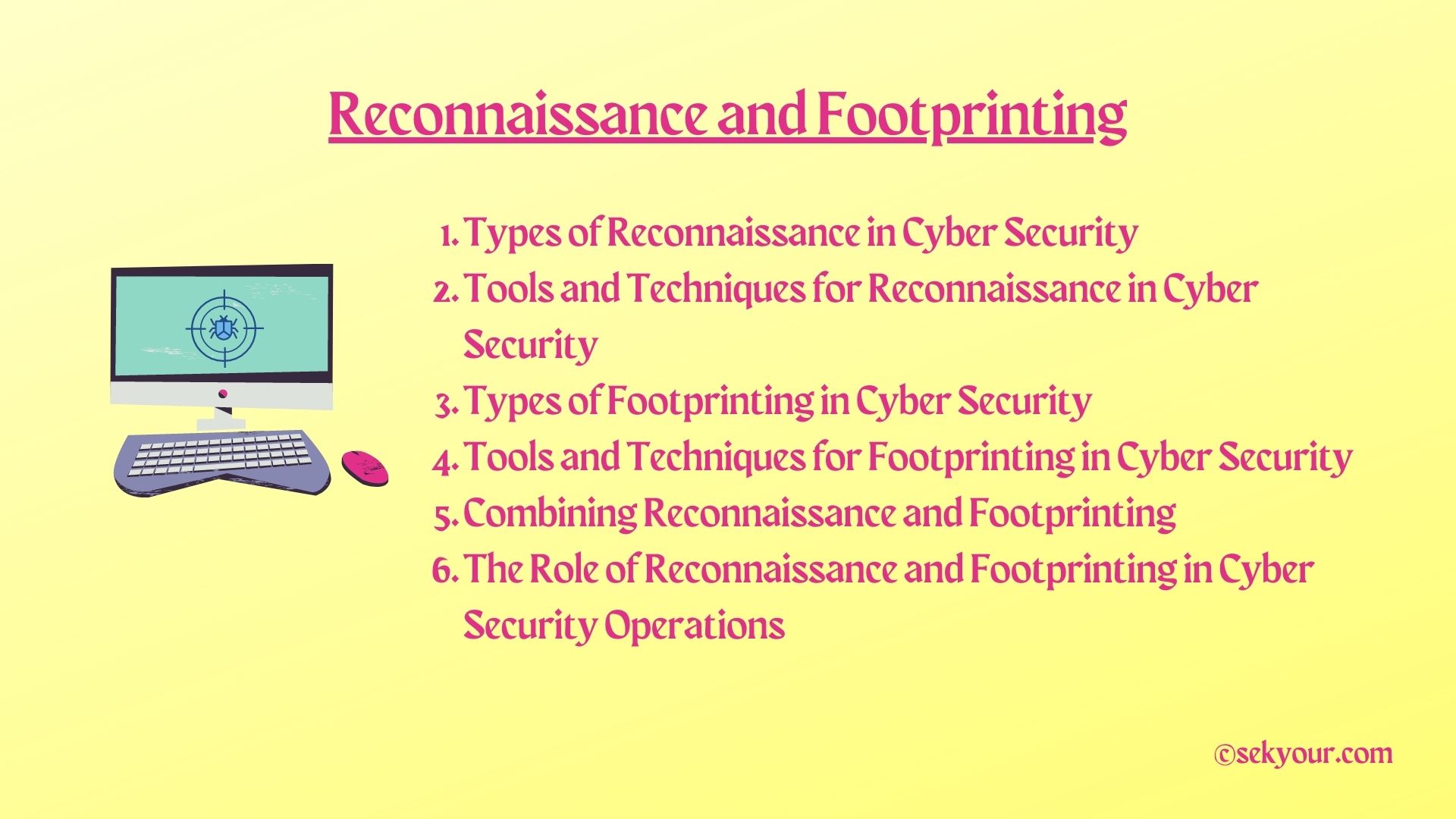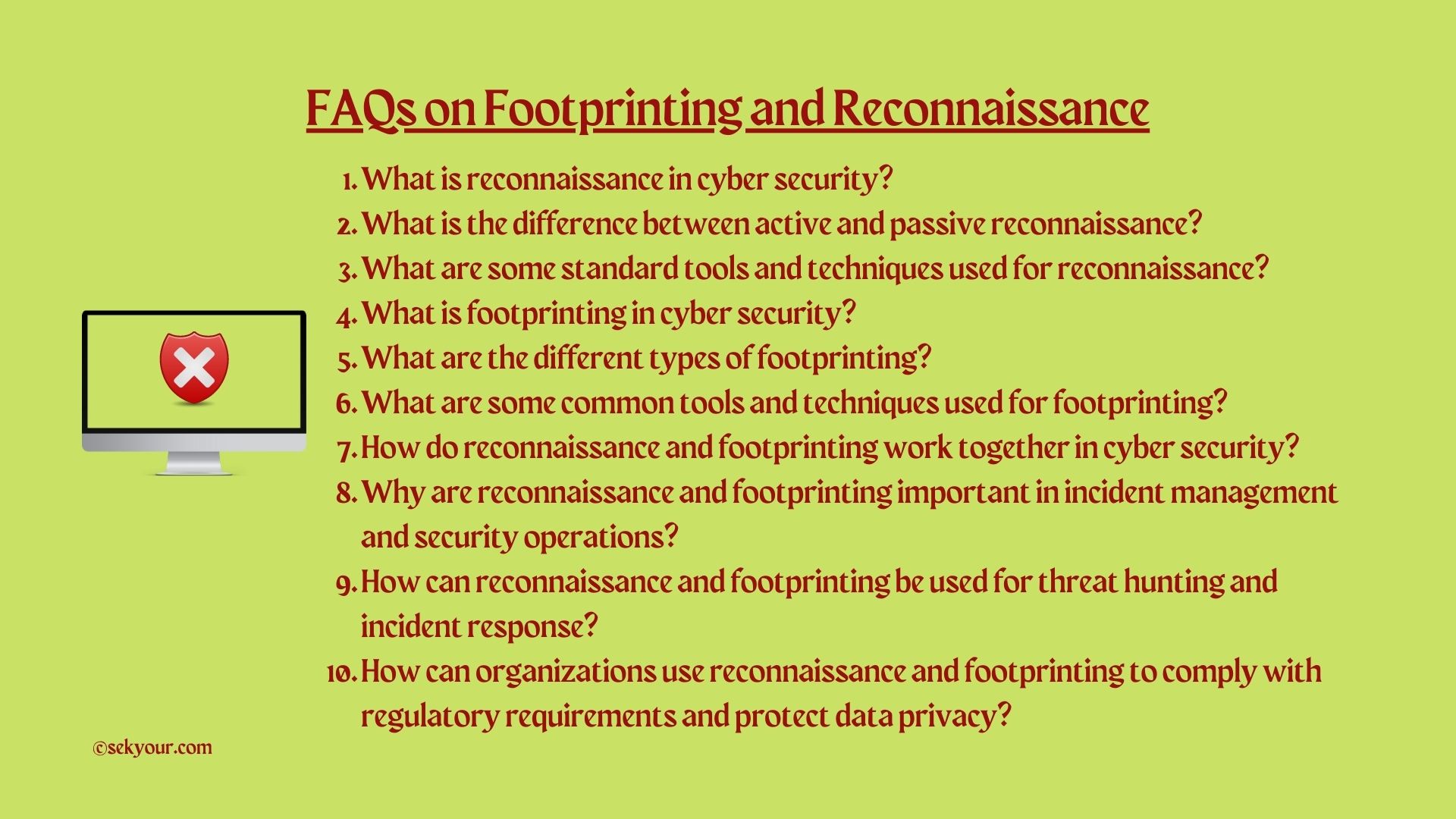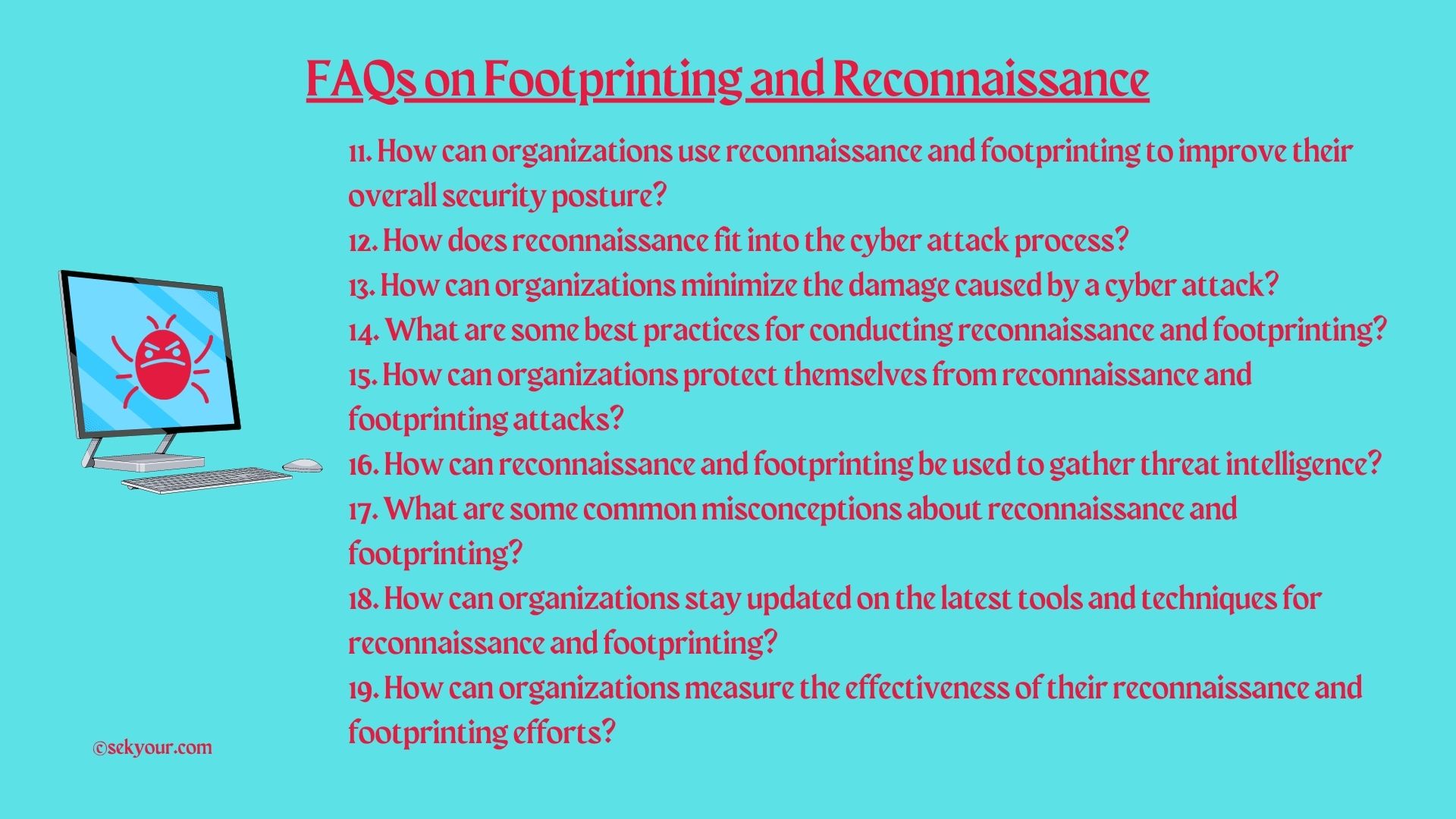1. Introduction
Reconnaissance and footprinting are essential components of Cybersecurity. They are used to gather information and identify vulnerabilities in a network or system. By conducting reconnaissance and footprinting, organizations can improve their overall security posture and reduce the risk of cyber attacks. This article will delve into the details of reconnaissance and footprinting, including their significance in the cyber attack process, different techniques and tools used, and the benefits of using them together in a coordinated effort.

2. Types of Reconnaissance in Cybersecurity
Reconnaissance is gathering information about a target before launching an attack. There are two main types of reconnaissance: active and passive.
Active reconnaissance involves interacting with the target to gather information, such as using port scanners or sending phishing emails. This type of reconnaissance is more likely to be detected and can cause damage to the target system.
On the other hand, passive reconnaissance involves gathering information about the target without interacting with it, such as using publicly available information or monitoring network traffic. This type of reconnaissance is less likely to be detected but yields less information.
Reconnaissance is typically the first phase in a cyber attack. It enables the attacker to gather information about the target’s systems and networks, identify vulnerabilities, and plan the next steps of the attack. Some of the reconnaissance tools and techniques that can be used are network reconnaissance techniques, web reconnaissance in Cybersecurity, and reconnaissance and enumeration.
According to a study by the Ponemon Institute, the average time it takes to identify a data breach is 206 days, and the average time to contain a breach is 73 days. With effective reconnaissance, organizations can detect and prevent breaches in a much shorter time, reducing the potential damage caused by a cyber attack.
3. Tools and Techniques for Reconnaissance in Cybersecurity
Reconnaissance and enumeration in Cybersecurity involve identifying the systems and services running on a target network and gathering information about them. This can be done using tools such as port scanners, which scan for open ports on a target system, and network mappers, which create a map of the target network. By identifying the systems and services running on a target network, an attacker can identify potential vulnerabilities to exploit.
Reconnaissance and profiling in Cybersecurity involve gathering information about the target organization, such as its structure, employees, and business operations. This information can tailor a cyber attack to a specific target. Social engineering techniques, such as phishing and pretexting, can be used to gather information about employees and business operations. Public records and social media can also collect information about the organization.
Reconnaissance and information gathering in Cybersecurity are the processes of collecting information about a target, such as IP addresses, DNS records, and email addresses. This information can be used to identify the target’s systems and networks, as well as its employees and business operations. Tools such as Google Hacking, OSINT, and passive DNS can be used to gather this information.
Reconnaissance and threat intelligence is gathering information about potential threats to an organization and analyzing it to identify trends and patterns. This information can be used to identify potential vulnerabilities in an organization’s systems and networks and potential attackers. Tools such as threat feeds, honeypots, and intrusion detection systems can be used to gather threat intelligence.
Reconnaissance is a crucial component of Cybersecurity, enabling organizations to identify potential vulnerabilities and attackers before a cyber attack occurs. A study by Accenture found that companies that implement threat intelligence and vulnerability management programs experience 60% fewer security breaches.
4. Types of Footprinting in CyberSecurity
Footprinting, like reconnaissance, is a method of gathering information about a target. However, footprinting specifically focuses on identifying the information that is publicly available about a target. Like reconnaissance, footprinting can be divided into two main categories: active and passive.
Active footprinting involves actively interacting with the target to gather information, such as by sending an email or making a phone call. This type of footprinting can be more easily detected and can cause damage to the target system.
On the other hand, passive footprinting involves gathering information about the target without interacting with it, such as searching public records or monitoring network traffic. This type of footprinting is less likely to be detected but yields less information.
The role of footprinting in information gathering and threat intelligence is to identify publicly available information about a target organization or individual that can be used to launch a cyber-attack. This information includes details about the target’s systems, networks, employees, and business operations. Footprinting can identify vulnerabilities in a target’s systems and networks and potential attackers.
Footprinting tools and techniques such as network footprinting, website footprinting in Cybersecurity and passive footprinting can be used to gather information about a target. Network footprinting tools can map a target’s network and identify the systems and services running on it. Website footprinting tools can be used to determine the technology and software used to build a website. Passive footprinting can gather information about a target by monitoring network traffic.
5. Tools and Techniques for Footprinting in Cybersecurity
Footprinting and vulnerability assessment identify vulnerabilities in a target’s systems and networks by gathering publicly available information. This information can be used to identify potential vulnerabilities that can be exploited during a cyber attack. Tools such as vulnerability scanners, penetration testing tools, and threat intelligence feeds can be used to gather this information.
Footprinting and incident response is identifying and responding to a cyber attack by gathering publicly available information about the attack and the attacker. This information can be used to identify the attack’s origin and the systems and networks affected by it. Tools such as intrusion detection systems, honeypots, and threat feeds can be used to gather this information.
Footprinting and compliance with regulatory requirements is identifying and responding to regulatory requirements by gathering publicly available information about the requirements and the target’s compliance with them. This information can be used to identify potential non-compliances and vulnerabilities that can be exploited during a cyber attack. Tools such as regulatory compliance scanners, penetration testing tools, and threat intelligence feeds can be used to gather this information.
Footprinting and data privacy is identifying and responding to data privacy breaches by gathering publicly available information about data breaches and data privacy regulations. This information can be used to identify potential data breaches and vulnerabilities that can be exploited during a cyber attack. Data leak prevention and detection systems, penetration testing tools, and threat intelligence feeds can be used to gather this information.
6. Combining Reconnaissance and Footprinting
Reconnaissance and footprinting are two important methods of gathering information about a target in Cybersecurity. They can be used together in a coordinated effort to gather more comprehensive information and identify more vulnerabilities.
Reconnaissance and footprinting can be used together to gather information about a target’s systems, networks, employees, and business operations. This information can be used to identify vulnerabilities in the target’s systems and networks and potential attackers. By using both techniques, organizations can gain a complete understanding of the target and reduce the risk of a successful cyber attack.
The benefits of using both techniques in a coordinated effort include the following:
- a more comprehensive understanding of the target
- identification of more vulnerabilities in the target’s systems and networks
- ability to identify potential attackers
- ability to reduce the risk of a successful cyber attack.
- Specific tools and techniques that can be used for combined reconnaissance and footprinting include reconnaissance and vulnerability scanning.
By using these tools and techniques together, organizations can more effectively identify vulnerabilities in their systems and networks and reduce the risk of a successful cyber attack.
7. The Role of Reconnaissance and Footprinting in Cybersecurity Operations
Reconnaissance and footprinting play a crucial role in incident management and security operations. By gathering information about a target’s systems, networks, employees, and business operations, organizations can identify potential vulnerabilities and attackers. This information can then prevent, detect, and respond to cyber-attacks.
In incident management, the role of reconnaissance and footprinting is to gather information about a target and use it to identify, contain, and eradicate a cyber attack. This information can also restore normal operations and prevent future attacks. By gathering information about a target’s systems, networks, employees, and business operations, organizations can more effectively respond to a cyber attack and minimize the damage caused.
8. Conclusion
Reconnaissance and footprinting are essential components of Cybersecurity. They are used to gather information and identify network or system vulnerabilities, enabling organizations to improve their overall security posture and reduce the risk of cyber attacks. This article discussed the different types of reconnaissance and footprinting, the tools and techniques used for each, and the benefits of using them together in a coordinated effort. Additionally, the article highlighted the importance of reconnaissance and footprinting in incident management, security operations, threat hunting, and incident response.
The significance of reconnaissance and footprinting in Cybersecurity cannot be overstated. As cybercrime continues to cost the world billions of dollars annually, it becomes increasingly important for organizations to understand and implement effective reconnaissance and footprinting techniques. This will enable them to detect and contain breaches in a much shorter time frame, reducing the potential damage caused by a cyber attack.
To further explore the topic of reconnaissance and footprinting in Cybersecurity, some several resources and publications can be consulted, such as the SANS Institute, the Center for Internet Security and the National Cyber-Forensics & Training Alliance. Additionally, attending security-related conferences or professional development training is a great way to stay updated on the latest tools and techniques for reconnaissance and footprinting in Cybersecurity.
9. FAQs on Footprinting and Reconnaissance

1. What is reconnaissance in Cybersecurity?
Reconnaissance in Cybersecurity is gathering information about a target before launching an attack. This information can be used to identify vulnerabilities in the target’s systems and networks and potential attackers. Reconnaissance is typically the first phase in a cyber attack, and it enables the attacker to plan the next steps of the attack.
2. What is the difference between active and passive reconnaissance?
Active reconnaissance involves interacting with the target to gather information, such as using port scanners or sending phishing emails. This type of reconnaissance is more likely to be detected and can cause damage to the target system. On the other hand, passive reconnaissance involves gathering information about the target without interacting with it, such as using publicly available information or monitoring network traffic. This type of reconnaissance is less likely to be detected but yields less information.
3. What are some standard tools and techniques used for reconnaissance?
Standard tools and techniques used for reconnaissance include network reconnaissance techniques, web reconnaissance, and reconnaissance and enumeration. Other tools include port scanners, network mappers, social engineering techniques, Google Hacking, OSINT, and passive DNS.
4. What is footprinting in Cybersecurity?
Footprinting in Cybersecurity gathers information about a target’s systems, networks, employees, and business operations. This information can be used to identify vulnerabilities in the target’s systems and networks and potential attackers.
5. What are the different types of footprinting?
The different types of footprinting are active and passive. Active footprinting involves actively interacting with the target to gather information, such as using port scanners or sending phishing emails. On the other hand, passive footprinting involves gathering information about the target without interacting with it, such as using publicly available information or monitoring network traffic.
6. What are some common tools and techniques used for footprinting?
Common tools and techniques for footprinting include network footprinting, website footprinting, and vulnerability assessment. Other tools include port scanners, network mappers, social engineering techniques, Google Hacking, OSINT, and passive DNS.
7. How do reconnaissance and footprinting work together in Cybersecurity?
Reconnaissance and footprinting are used in Cybersecurity to gather more comprehensive information about a target and identify more vulnerabilities. By using both techniques, organizations can better understand the target and reduce the risk of a successful cyber attack.
8. Why are reconnaissance and footprinting important in incident management and security operations?
Reconnaissance and footprinting are necessary in incident management and security operations because they allow organizations to identify potential vulnerabilities and attackers before a cyber attack occurs. This information can be used to prevent, detect, and respond to cyber-attacks and to improve an organization’s overall security posture.
9. How can reconnaissance and footprinting be used for threat hunting and incident response?
Reconnaissance and footprinting can be used for threat hunting and incident response by gathering information about potential threats to an organization. This information can be used to identify, contain, and eradicate cyber attacks. Additionally, reconnaissance and footprinting can improve an organization’s security posture by identifying potential vulnerabilities and attackers.
10. How can organizations use reconnaissance and footprinting to comply with regulatory requirements and protect data privacy?
Reconnaissance and footprinting can be used to comply with regulatory requirements and protect data privacy by gathering information about an organization’s systems, networks, employees, and business operations. This information can be used to identify vulnerabilities in the organization’s systems and networks and potential attackers. Additionally, reconnaissance and footprinting can be used to ensure that an organization complies with regulatory requirements, such as HIPAA and PCI-DSS, and to protect data privacy.

11. How can organizations use reconnaissance and footprinting to improve their overall security posture?
Organizations can use reconnaissance and footprinting to improve their overall security posture by identifying potential vulnerabilities and attackers before a cyber attack occurs. This information can be used to prevent, detect, and respond to cyber attacks and improve an organization’s security posture. Additionally, by conducting reconnaissance and footprinting, organizations can better understand their target and tailor their security measures to protect against cyber attacks more effectively.
12. How does reconnaissance fit into the cyber attack process?
Reconnaissance is typically the first phase in a cyber attack. It involves gathering information about a target before launching an attack. This information can be used to identify vulnerabilities in the target’s systems and networks and potential attackers. By conducting reconnaissance, attackers can plan the next steps of the attack and increase the chances of success.
13. How can organizations minimize the damage caused by a cyber attack?
Organizations can minimize the damage caused by a cyber attack by identifying and containing the attack as quickly as possible. This can be done by conducting reconnaissance and footprinting to identify potential vulnerabilities and attackers before an attack takes place and by having incident management and incident response plans in place. Additionally, organizations can minimize the damage caused by a cyber attack by conducting regular vulnerability assessments and security audits and by training employees to identify and respond to cyber attacks.
14. What are some best practices for conducting reconnaissance and footprinting?
Best practices for conducting reconnaissance and footprinting include identifying the scope of the reconnaissance or footprinting, obtaining legal permission before conducting reconnaissance or footprinting, avoiding interactions with the target that could cause damage or alert the target, and documenting all information gathered during reconnaissance and footprinting. Additionally, it’s essential to use various techniques and tools to gather information from different sources.
15. How can organizations protect themselves from reconnaissance and footprinting attacks?
Organizations can protect themselves from reconnaissance and footprinting attacks by implementing security measures to detect and prevent reconnaissance and footprinting, such as intrusion detection systems, firewalls, and security information and event management (SIEM) systems. Additionally, organizations can protect themselves by implementing security best practices, such as regularly patching systems and software, conducting vulnerability assessments, and training employees to identify and respond to cyber-attacks.
16. How can reconnaissance and footprinting be used to gather threat intelligence?
Reconnaissance and footprinting can gather threat intelligence by identifying potential threats to an organization, such as new or emerging vulnerabilities, and analyzing the information to identify trends and patterns. This information can then be used to identify potential vulnerabilities in an organization’s systems and networks and potential attackers.
17. What are some common misconceptions about reconnaissance and footprinting?
Some common misconceptions about reconnaissance and footprinting include that attackers only use it for cybercrime and that it is only used for large-scale attacks. However, reconnaissance and footprinting can also be used by organizations to improve their overall security posture and to comply with regulatory requirements.
18. How can organizations stay updated on the latest tools and techniques for reconnaissance and footprinting?
Organizations can stay updated on the latest tools and techniques for reconnaissance and footprinting by attending security-related conferences or professional development training, reading security-related publications, and participating in online security communities.
19. How can organizations measure the effectiveness of their reconnaissance and footprinting efforts?
Organizations can measure the effectiveness of their reconnaissance and footprinting efforts by evaluating the quality and quantity of information gathered and assessing the organization’s overall security posture. Additionally, organizations can measure the effectiveness of their reconnaissance and footprinting efforts by tracking metrics such as the number and severity of cyber attacks, the time it takes to identify and contain data breaches, and the overall cost of Cybersecurity efforts.